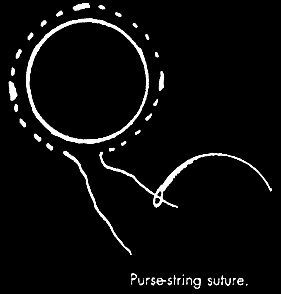A better way to close a posted case
Dealing with slipperiness
The Semi-Fowler Position (pics)
Mouth Closure
Getting sufficient fluid into hands
Proper shampoo and hair care methods
Eye closure
Dressing a Case (pics)
Blow out patch
Back Problems
|
This month’s tip comes to us courtesy of Mr. Roger Lori. It focuses on a problem which may start small but could end up causing a much greater problem if not handled quickly and correctly. (“Correctly” is the operative word – too often this procedure is done poorly, which can end up disastrously.)
An “old trade embalmer,” many years ago, taught Roger the “Blow-Out Patch” method of dealing with small and not-so-small lacerations, needle holes and other cuts or tears in the skin which cause stubborn areas of leakage. Here’s how to prevent or stop the problem, per Roger:
Clean the area well and, if the laceration is small, open it up a bit more with an instrument so you have some room to work. Take a piece of cotton and soak the area for about 15 minutes with a cauterizing agent. Next, remove the cotton, dry well and apply some dry seal powder. Clean the area, and, by using a purse-string stitch, suture the area tightly. Clean and dry the area again and apply some Super Glue; let dry for about 10 minutes. Next, apply some incision sealer, but the trick here is to apply over the area AND WELL AROUND THE AREA, GOING ABOUT THREE INCHES IN ALL DIRECTIONS. Apply a piece of flat cotton and wrap with thin plastic, the type you get from the dry cleaners, or plastic wrap (such as Saran Wrap). This type of plastic is best because a family cannot feel or hear it. Now, apply plastic well beyond the treatment area. Next, use tape to secure the plastic. If you have a large area to treat, the same treatment will work; just do the procedure on a larger scale. If you have needle holes on a non-viewing area, simply make the hole larger with the tip of a scalpel blade or end of scissors and apply a trocar button. If the hole is in a viewing area such as a hand or high neck, usually a drop of Super Glue will suffice.
Thank you, Roger, for some very good advice!
NOTE: The “purse-string suture,” according to Restorative Art (J. Sheridan Mayer), “is made before (or after) embalming to hold the margins of small holes in position. A series of small stitches through the derma is made around the circumference of the opening. The ends of the thread are knotted within the opening. A small excess of thread is permitted to remain.”

|

Jansen Professional Services are provided by Jansen Family Funeral Home
A family owned funeral home licensed and located in the state Michigan to provide funeral & cremation services.
All web content and design Copyright © 2013 Jansen Family Funeral Home, Inc.
Office: 810-793-6234 / Fax: 810-793-4752
Jansen Family Funeral Home / 4705 Pine Street / Columbiaville, MI 48421
Daniel L. Jansen, Manager/Director
|